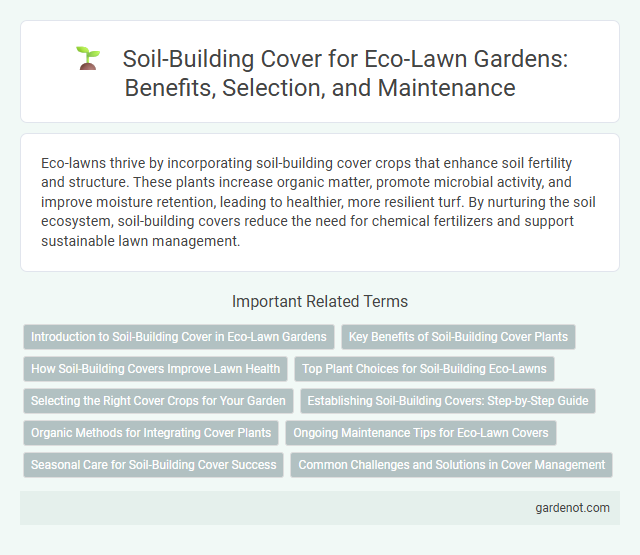Eco-lawns thrive by incorporating soil-building cover crops that enhance soil fertility and structure. These plants increase organic matter, promote microbial activity, and improve moisture retention, leading to healthier, more resilient turf. By nurturing the soil ecosystem, soil-building covers reduce the need for chemical fertilizers and support sustainable lawn management.
Introduction to Soil-Building Cover in Eco-Lawn Gardens
Soil-building cover crops in eco-lawn gardens enhance soil fertility by fixing nitrogen, improving organic matter, and promoting microbial activity. These cover plants, such as clover and vetch, reduce soil erosion and increase moisture retention, supporting healthier turfgrass growth. Employing soil-building covers creates resilient, nutrient-rich soil ecosystems that minimize the need for synthetic fertilizers and promote sustainable lawn maintenance.
Key Benefits of Soil-Building Cover Plants
Soil-building cover plants enhance soil fertility by fixing nitrogen, increasing organic matter, and improving soil structure, which supports healthier grass growth in eco-lawns. Their extensive root systems reduce erosion and promote water infiltration, helping to maintain soil moisture and reduce runoff. These plants also suppress weeds by outcompeting them, leading to a denser, more resilient turf with less need for chemical inputs.
How Soil-Building Covers Improve Lawn Health
Soil-building cover crops enhance lawn health by increasing organic matter, improving soil structure, and boosting microbial activity. These covers promote nutrient cycling, retain moisture, and reduce erosion, creating a resilient environment for grass roots. By fostering beneficial soil organisms, they support robust root development and reduce the need for synthetic fertilizers.
Top Plant Choices for Soil-Building Eco-Lawns
Top plant choices for soil-building eco-lawns include clover, fescue, and ryegrass, which enhance soil fertility and structure through nitrogen fixation and deep root systems. White clover (Trifolium repens) improves soil nitrogen levels naturally, promoting healthier turf growth without chemical fertilizers. Tall fescue (Festuca arundinacea) provides drought resistance and soil aeration, while perennial ryegrass (Lolium perenne) supports soil microbial activity and rapid ground cover establishment.
Selecting the Right Cover Crops for Your Garden
Choosing the right cover crops for your eco-lawn significantly improves soil health by enhancing nutrient retention and preventing erosion. Leguminous plants like clover and vetch fix nitrogen, while deep-rooted species such as ryegrass break up compacted soil layers. Incorporating diverse cover crops tailored to your garden's climate and soil type boosts organic matter and supports beneficial microbial activity.
Establishing Soil-Building Covers: Step-by-Step Guide
Establishing soil-building cover crops involves selecting nutrient-rich species like clover, vetch, or rye to enhance soil structure and fertility. Prepare the soil by clearing debris and loosening the top layer before evenly sowing seeds at the recommended rate, then water consistently to promote germination. Regularly monitor growth to manage weeds and ensure the cover crop contributes organic matter and nitrogen fixation for improved eco-lawn health.
Organic Methods for Integrating Cover Plants
Organic methods for integrating soil-building cover plants in eco-lawns enhance soil fertility by increasing organic matter and microbial activity. Leguminous cover crops such as clover and vetch fix atmospheric nitrogen, reducing the need for synthetic fertilizers and improving nutrient cycling. These practices support soil structure, moisture retention, and long-term lawn health, essential for sustainable eco-lawn management.
Ongoing Maintenance Tips for Eco-Lawn Covers
Consistent watering ensures soil moisture levels support deep root growth for eco-lawn covers, enhancing drought resistance and nutrient uptake. Periodic mowing at a height of 3 to 4 inches encourages dense turf development, reducing weed infiltration and promoting soil health. Incorporating organic mulch or compost annually enriches soil microbial activity, improves structure, and sustains nutrient cycling vital for eco-lawn longevity.
Seasonal Care for Soil-Building Cover Success
Seasonal care is crucial for soil-building cover crops to enhance soil health and nutrient cycling effectively. Regular monitoring of moisture levels and timely mowing prevent thatch buildup, promoting root growth and organic matter incorporation. Adjusting planting schedules according to local climate conditions maximizes biomass production and improves soil structure throughout the year.
Common Challenges and Solutions in Cover Management
Soil-building cover crops in eco-lawns often face challenges like nutrient depletion, soil compaction, and pest infestation, which can hinder healthy turf growth. Effective cover management techniques include selecting deep-rooted legumes to fix nitrogen, employing diverse crop rotations to improve soil structure, and integrating organic mulches to enhance moisture retention and suppress weeds. Regular monitoring and timely mowing help maintain optimal plant density and prevent competitive stress on the soil ecosystem.
Soil-building cover Infographic

 gardenot.com
gardenot.com